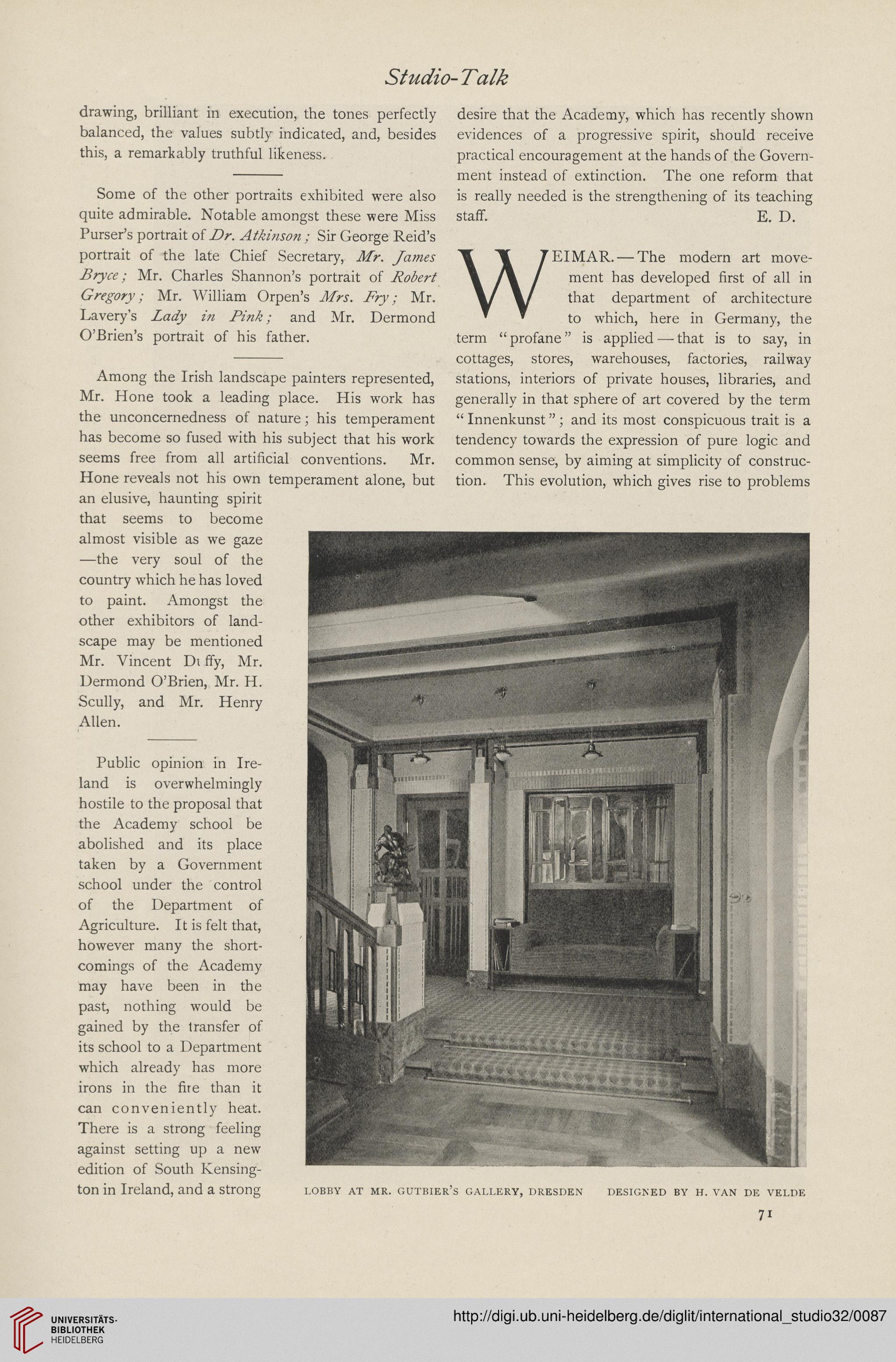Studio-Talk
Public opinion in Ire-
land is overwhelmingly
hostile to the proposal that
the Academy school be
abolished and its place
taken by a Government
school under the control
of the Department of
Agriculture. It is felt that,
however many the short-
comings of the Academy
may have been in the
past, nothing would be
gained by the transfer of
its school to a Department
which already has more
irons in the fire than it
can conveniently heat.
There is a strong feeling
against setting up a new
edition of South Kensing-
ton in Ireland, and a strong
LOBBY AT MR. GUTBIER’s GALLERY, DRESDEN DESIGNED BY H. VAN DE VELDE
desire that the Academy, which has recently shown
evidences of a progressive spirit, should receive
practical encouragement at the hands of the Govern-
ment instead of extinction. The one reform that
is really needed is the strengthening of its teaching
staff. E. D.
WEIMAR. — The modern art move-
ment has developed first of all in
that department of architecture
to which, here in Germany, the
term “profane” is applied — that is to say, in
cottages, stores, warehouses, factories, railway
stations, interiors of private houses, libraries, and
generally in that sphere of art covered by the term
“ Innenkunst ” ; and its most conspicuous trait is a
tendency towards the expression of pure logic and
common sense, by aiming at simplicity of construc-
tion. This evolution, which gives rise to problems
drawing, brilliant in execution, the tones perfectly
balanced, the values subtly indicated, and, besides
this, a remarkably truthful likeness.
Some of the other portraits exhibited -were also
quite admirable. Notable amongst these were Miss
Purser’s portrait of Dr. Atkinson ; Sir George Reid’s
portrait of the late Chief Secretary, Mr. James
Bryce; Mr. Charles Shannon’s portrait of Robert
Gregory; Mr. William Orpen’s Mrs. Fry; Mr.
Lavery’s Lady in Pink; and Mr. Dermond
O’Brien’s portrait of his father.
Among the Irish landscape painters represented,
Mr. Hone took a leading place. His work has
the unconcernedness of nature; his temperament
has become so fused with his subject that his work
seems free from all artificial conventions. Mr.
Hone reveals not his own temperament alone, but
an elusive, haunting spirit
that seems to become
almost visible as we gaze
—the very soul of the
country which he has loved
to paint. Amongst the
other exhibitors of land-
scape may be mentioned
Mr. Vincent Di ffy, Mr.
Dermond O’Brien, Mr. H.
Scully, and Mr. Henry
Allen.
7i
Public opinion in Ire-
land is overwhelmingly
hostile to the proposal that
the Academy school be
abolished and its place
taken by a Government
school under the control
of the Department of
Agriculture. It is felt that,
however many the short-
comings of the Academy
may have been in the
past, nothing would be
gained by the transfer of
its school to a Department
which already has more
irons in the fire than it
can conveniently heat.
There is a strong feeling
against setting up a new
edition of South Kensing-
ton in Ireland, and a strong
LOBBY AT MR. GUTBIER’s GALLERY, DRESDEN DESIGNED BY H. VAN DE VELDE
desire that the Academy, which has recently shown
evidences of a progressive spirit, should receive
practical encouragement at the hands of the Govern-
ment instead of extinction. The one reform that
is really needed is the strengthening of its teaching
staff. E. D.
WEIMAR. — The modern art move-
ment has developed first of all in
that department of architecture
to which, here in Germany, the
term “profane” is applied — that is to say, in
cottages, stores, warehouses, factories, railway
stations, interiors of private houses, libraries, and
generally in that sphere of art covered by the term
“ Innenkunst ” ; and its most conspicuous trait is a
tendency towards the expression of pure logic and
common sense, by aiming at simplicity of construc-
tion. This evolution, which gives rise to problems
drawing, brilliant in execution, the tones perfectly
balanced, the values subtly indicated, and, besides
this, a remarkably truthful likeness.
Some of the other portraits exhibited -were also
quite admirable. Notable amongst these were Miss
Purser’s portrait of Dr. Atkinson ; Sir George Reid’s
portrait of the late Chief Secretary, Mr. James
Bryce; Mr. Charles Shannon’s portrait of Robert
Gregory; Mr. William Orpen’s Mrs. Fry; Mr.
Lavery’s Lady in Pink; and Mr. Dermond
O’Brien’s portrait of his father.
Among the Irish landscape painters represented,
Mr. Hone took a leading place. His work has
the unconcernedness of nature; his temperament
has become so fused with his subject that his work
seems free from all artificial conventions. Mr.
Hone reveals not his own temperament alone, but
an elusive, haunting spirit
that seems to become
almost visible as we gaze
—the very soul of the
country which he has loved
to paint. Amongst the
other exhibitors of land-
scape may be mentioned
Mr. Vincent Di ffy, Mr.
Dermond O’Brien, Mr. H.
Scully, and Mr. Henry
Allen.
7i




